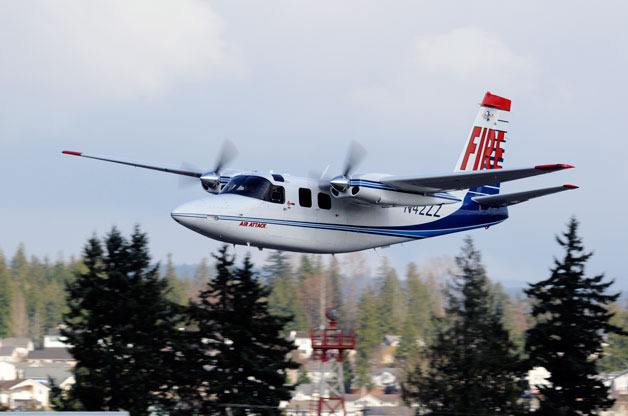ARLINGTON — Brad Goldman took a chance when his wife insisted that he purchase his first airplane — a 1963 Cessna 205 with only 1,800 hours on it.
At the time, he didn’t know that that investment would eventually lead him to spend his summers battling Northwest wildfires as an air attack specialist contracting with the U.S. Forest Service and other agencies.
“At first, I didn’t know what air attacks were,” said Goldman, a Marysville resident who owns and operates Gold Aero Flying Service in Arlington. “I found out that these aircraft circle over these wildfires and help (officials) oversee the airspace.”
For the past nine years, Goldman, who is also a full-time firefighter for Snohomish County Fire District 7, has spent July through September on call by his various contractors, ready to respond to wildfires.
His Twin Commander 500S Shrike airplane — equipped with specialized radio and fire equipment beyond anything found on his Cessna — sees a lot of use during those months as he serves in his role providing an eye in the sky for supervisors of wildfire responses primarily in eastern Washington and beyond into Oregon and Idaho.
On call
The process is similar to how firefighters respond to a call. Goldman receives a call from an individual on his contract list who gives him a brief overview of the situation.
Goldman fills his plane with fuel and takes off to a location where officials have set up a base camp. Once he arrives, he meets with an air attack supervisor and provides him with an aircraft so that they can make tactical decisions on the fire while flying directly over it.
Goldman pilots the plane while the supervisor communicates with air and ground units, such as tankers, helicopters and fire trucks. The duo also help cue crews in on weather changes.
Large wildfires, which sometimes have smoke plumes that reach thousands of feet into the air, can oftentimes cause thunderstorms, which can make the already-dangerous situation even worse.
“We’re basically in the air keeping everything organized and safe,” he said. “We have a really good vantage point.”
Prioritizing safety
Goldman said that each fire presents a unique set of challenges. Topography, the presence of homes and other factors all play a role in how responders deal with a fire that can reach hundreds of acres in size.
“Most people have no idea the amount of energy these fires have,” he said. “Sometimes there are tree limbs being carried up in smoke.”
Goldman said that if you’ve heard of any major fires that have taken place in the past few years, chances are he was involved in helping extinguish them.
Those wildfires have ranged in size from 179,000-acre blaze on national and state forest land near Winthrop in 2006 to a nearly 1,000-acre fire near Colville, Wash., this year.
While most of the fires Goldman responds to require a few days or weeks worth of work, the Winthrop fire kept him in eastern Washington from July through October.
He usually stays in a hotel until his services are no longer necessary.
Recently, he has not been required as often.
Goldman said that he’s responded to seven fires during summer 2010, with none of them being particularly large.
“The last two years we’ve been really lucky,” he said. “There have been a few lightning storms that didn’t take.”
Not his only gig
When Goldman is not responding to fires, both on ground and in the air, he’s operating his business out of Arlington Municipal Airport.
The company, which provides customers with recreational air travel, transportation or even scientific ventures, is made up of Goldman, a second pilot and three mechanics that keep Goldman’s two airplanes serviced and safe.
His 4,000-square-foot hanger houses both his Cessna and his Twin Commander — two different planes for two very different parts of Goldman’s life.
While the Cessna meets Goldman’s commercial customers, his Twin Commander, which he purchased and restored specifically for his wildfire contracts, is strictly used for his summer work.
“In the Cessna, we have a lot of biologists doing bird surveys who want go really low and slow,” Goldman said. “In the Twin, it’s much faster and heavier. It’s also faster, so it can get to the other side of a fire quickly.”



